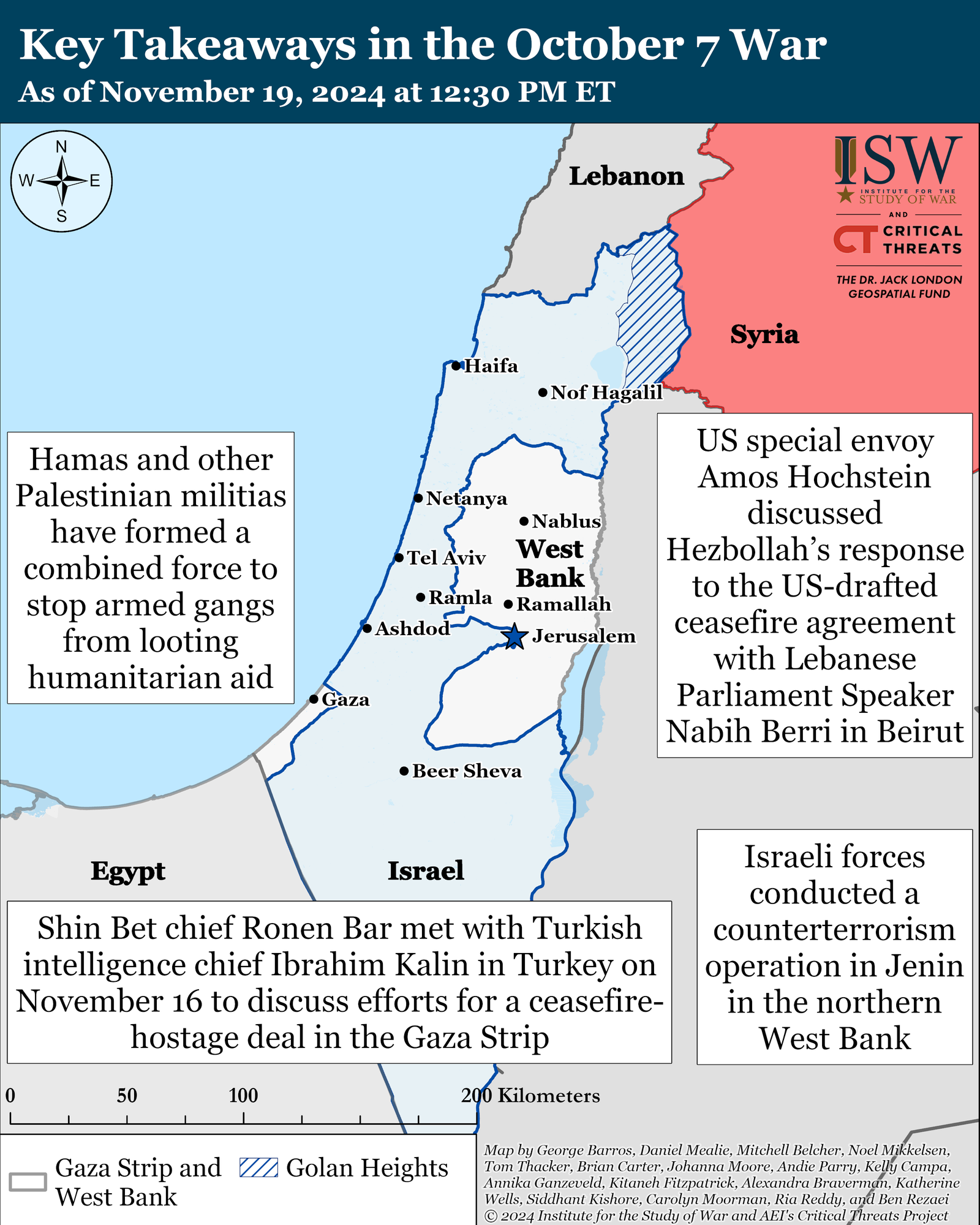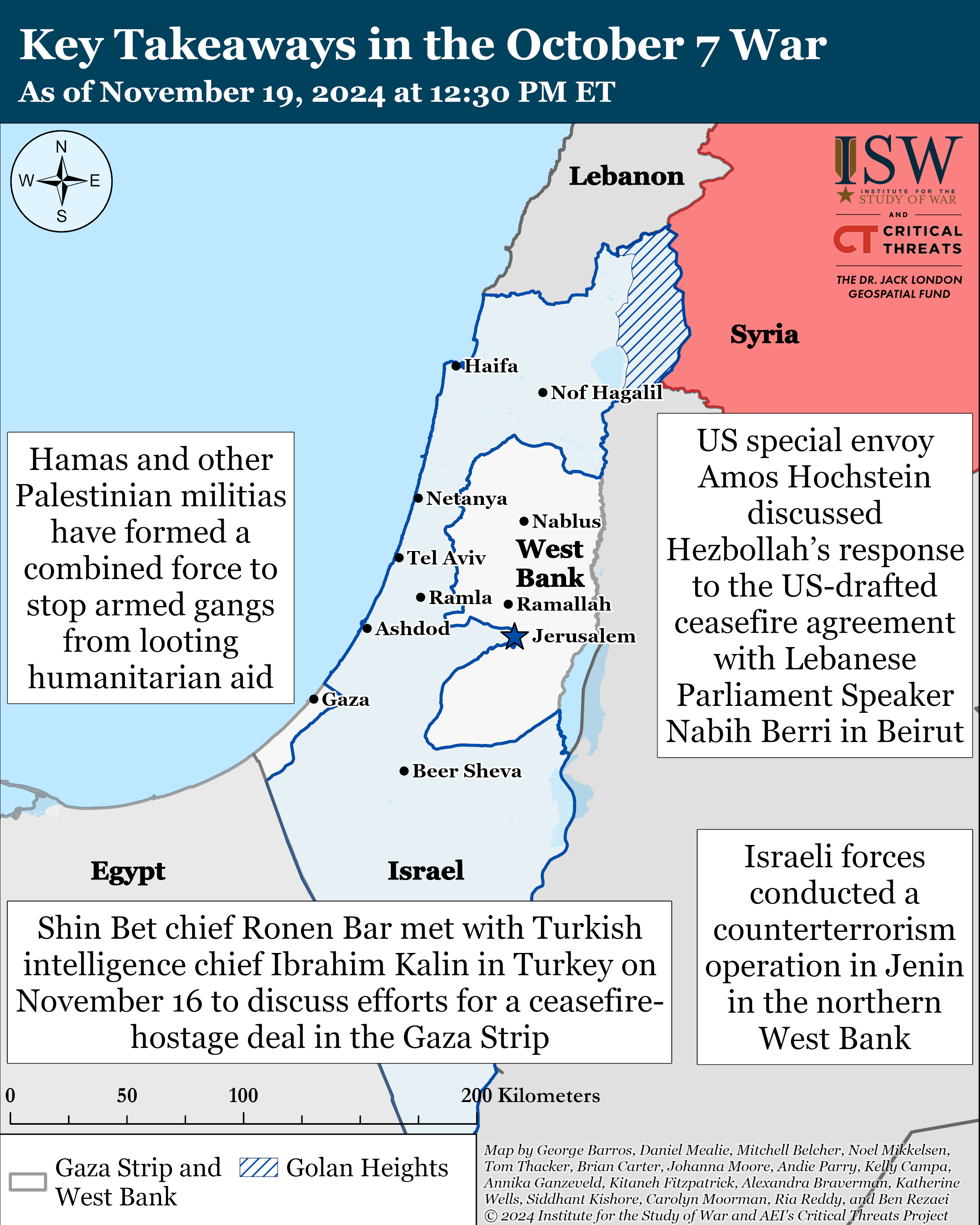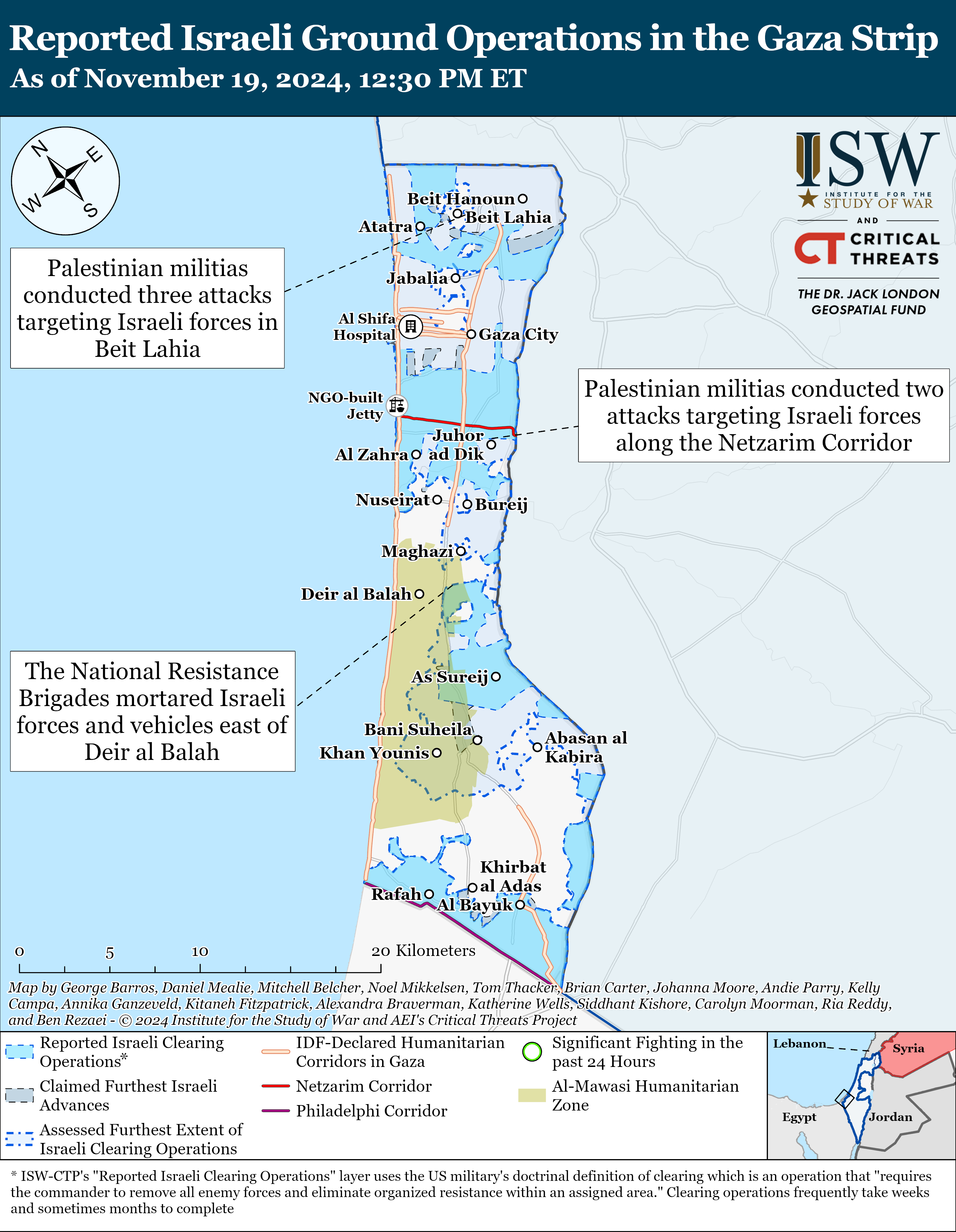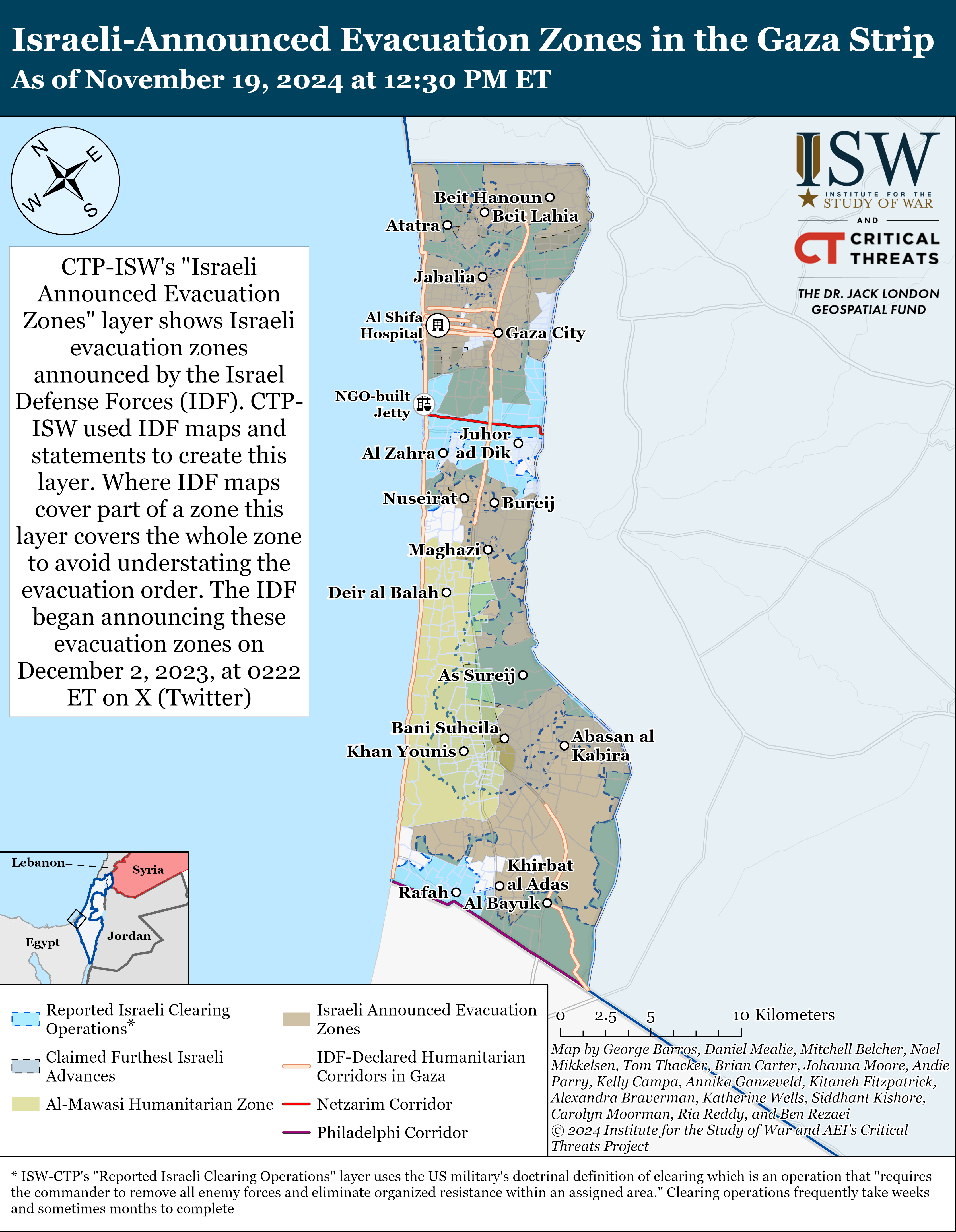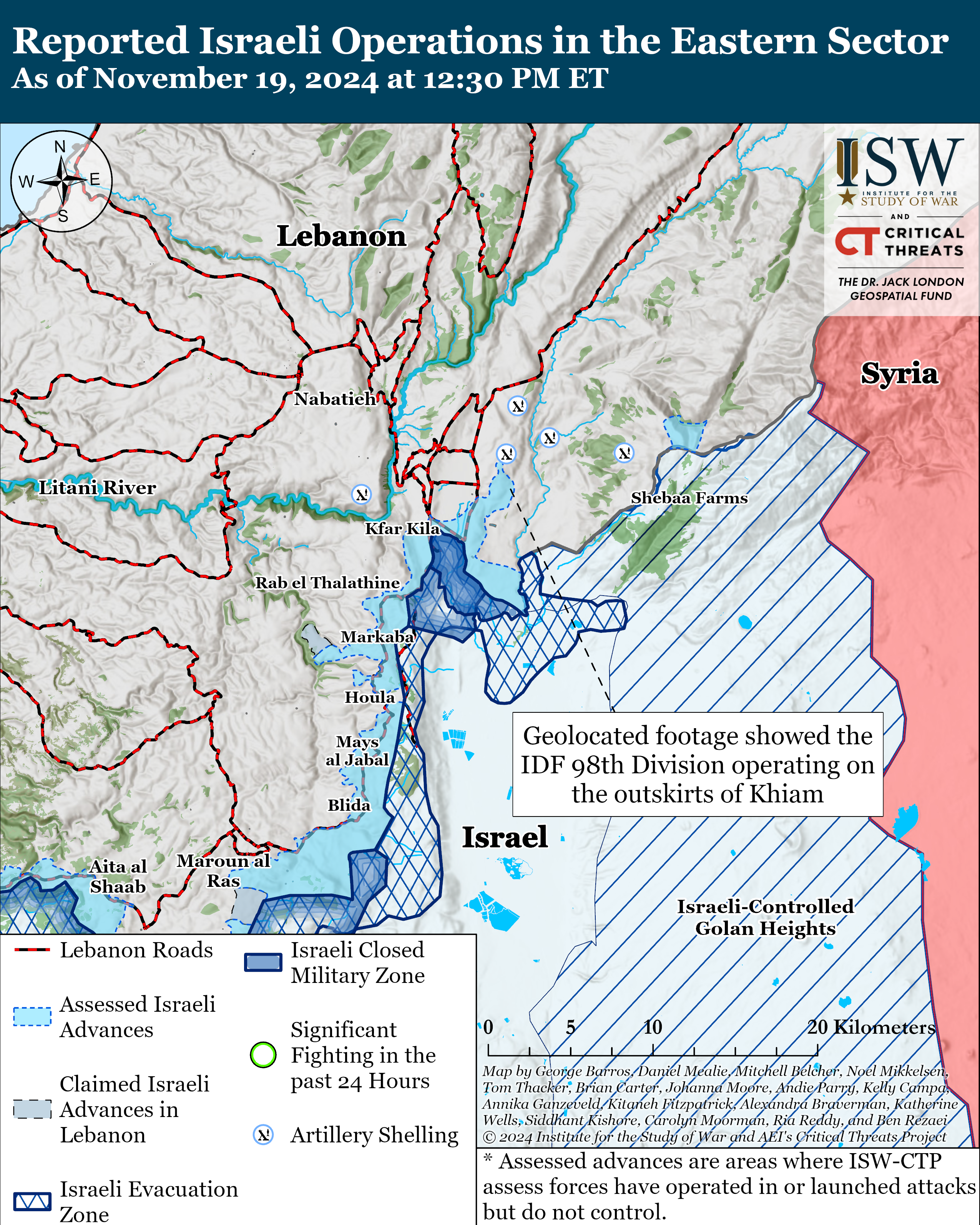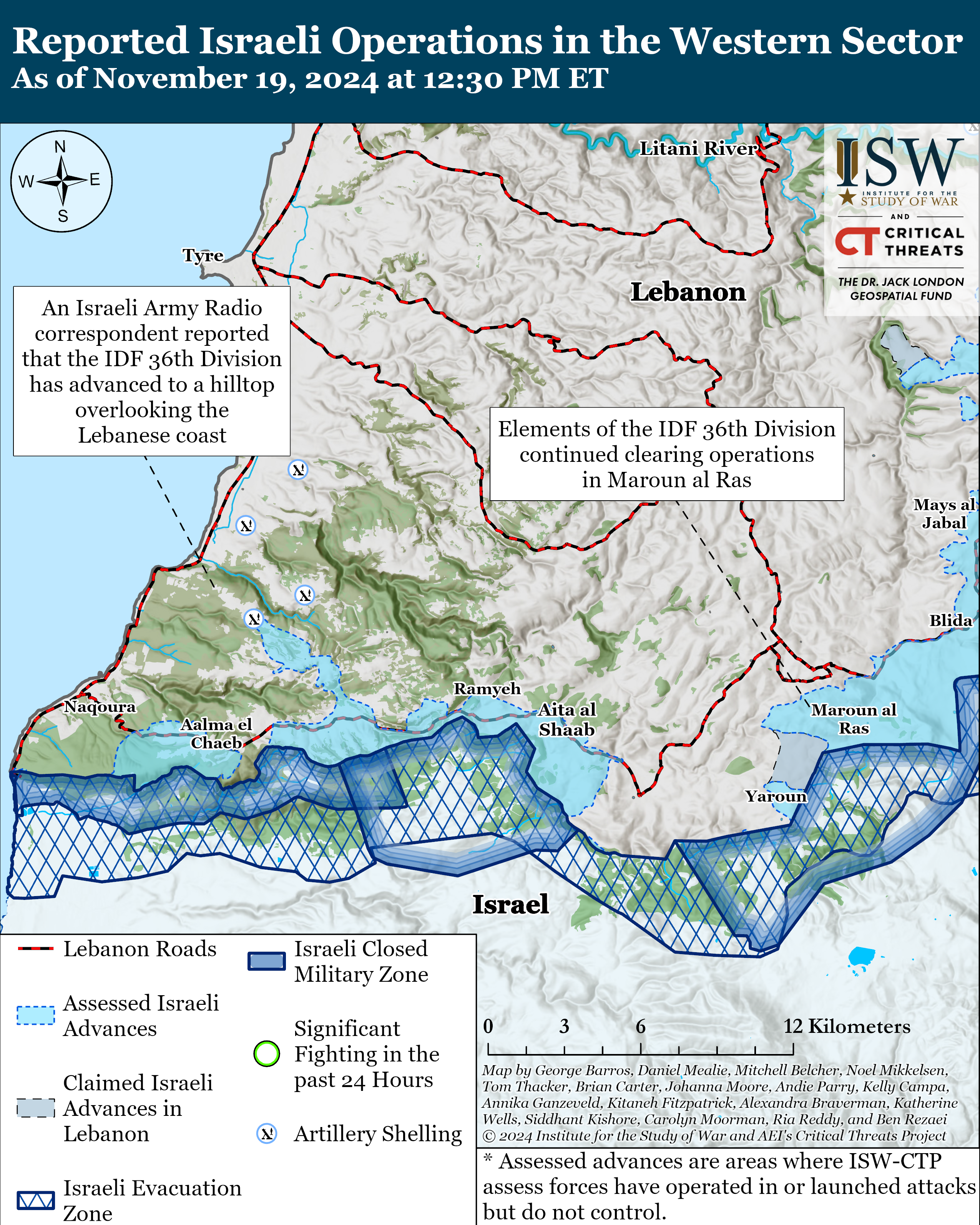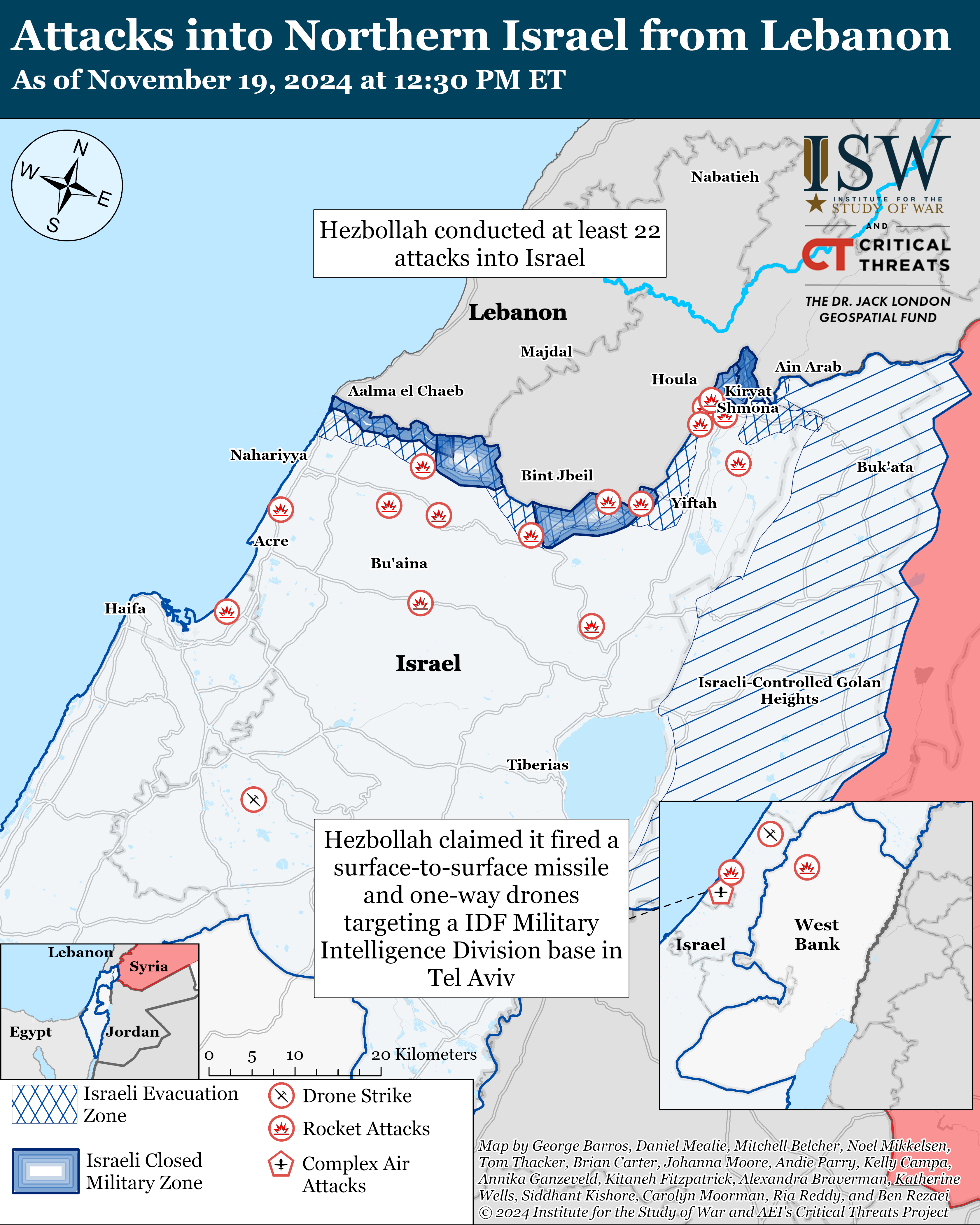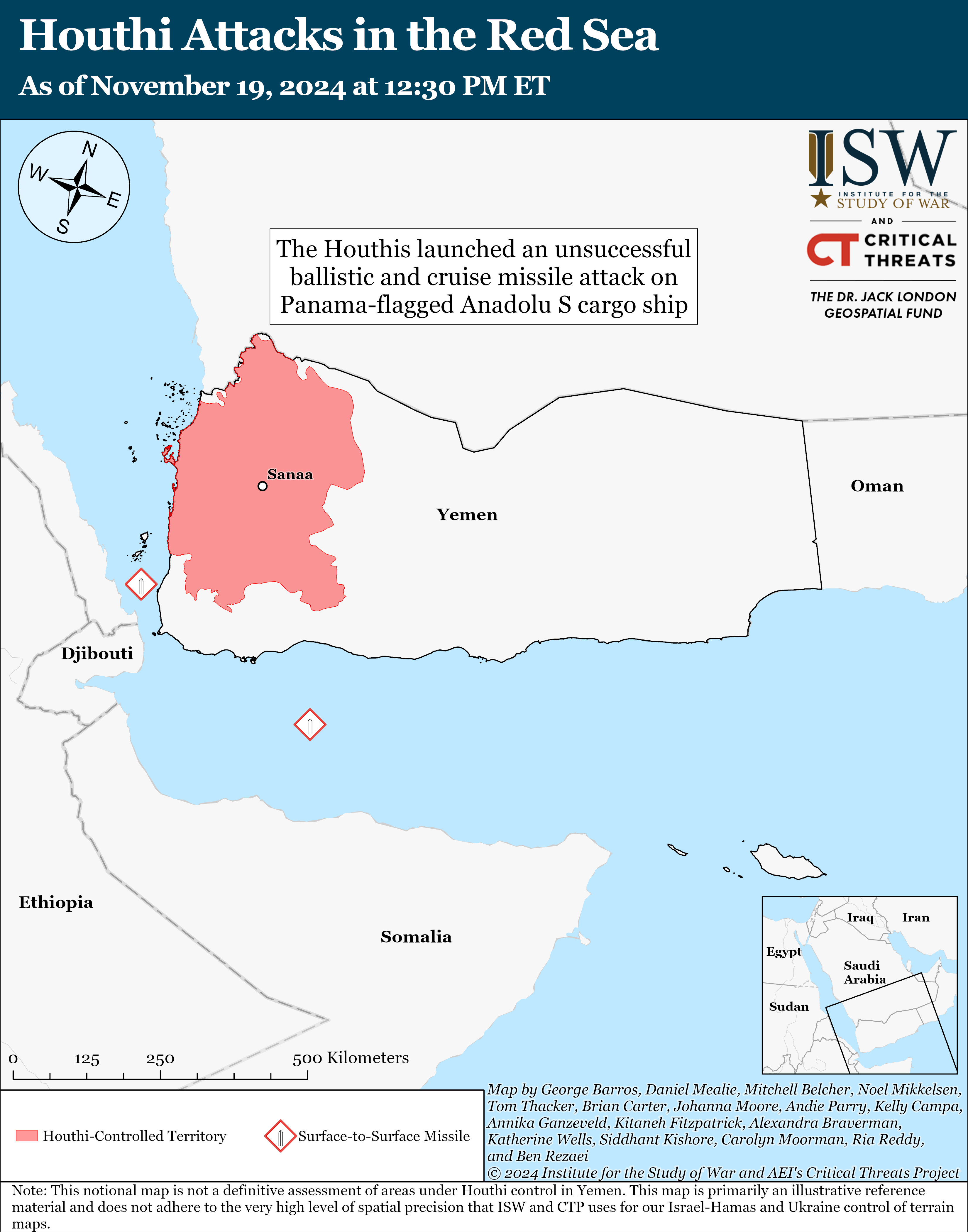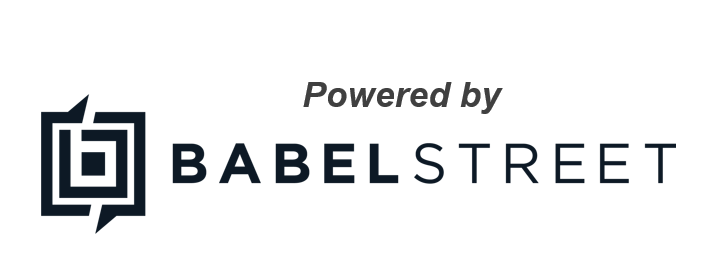10 hours ago
Information Cutoff: 12:30 pm ET
The Critical Threats Project (CTP) at the American Enterprise Institute and the Institute for the Study of War (ISW) publish the Iran Update, which provides insights into Iranian and Iranian-sponsored activities that undermine regional stability and threaten US forces and interests. Click here to see CTP and ISW’s interactive map of Israeli ground operations. This map is updated daily alongside the static maps present in this report.
We do not report in detail on war crimes because these activities are well-covered in Western media and do not directly affect the military operations we are assessing and forecasting. We utterly condemn violations of the laws of armed conflict and the Geneva Conventions and crimes against humanity even though we do not describe them in these reports.
CTP-ISW is publishing an abbreviated update today, November 19, 2024. We will resume our regular, full coverage of the October 7 War on November 20, 2024.
Hamas and other unidentified Palestinian militias have formed a combined force to stop armed gangs from looting humanitarian aid, which indicates that Hamas has only limited control of the Gaza Strip.[i] It remains unclear if Hamas distributes the aid equitably after it recovers stolen aid. Reuters reported on November 19 that Hamas and other militias created a force called the Popular and Revolutionary Committees in November 2024 to address rising Palestinian civilian anger at aid seizures and price gouging. Palestinian sources claimed that this newly created force has conducted multiple operations this month, killing several armed looters. The IDF has repeatedly said that armed groups loot humanitarian aid in the Gaza Strip. Armed criminal groups seized 98 out of 109 aid trucks in an incident in the southern Strip on November 16.[ii] A Hamas official told Reuters that the force shows Hamas’ continued control of governance in the Gaza Strip. The reality that criminal organizations are capable and willing to interdict these aid shipments indicates that these groups no longer fear Hamas to the degree they did pre-war.[iii] This suggests that Hamas’ ability to maintain control over the Strip has weakened considerably. The creation of a combined organization to counter this loss of control indicates Hamas is taking steps to regain control over the Strip, however.
Israeli media reported on November 18 that Shin Bet chief Ronen Bar met with Turkish intelligence chief Ibrahim Kalin in Turkey on November 16 to discuss efforts for a ceasefire-hostage deal in the Gaza Strip.[iv] Israeli media reported on November 17 that Hamas’ political leadership had relocated from Qatar to Turkey after Qatari officials reportedly ordered Hamas’ political leadership to relocate from Qatar.[v] Hamas and an anonymous Turkish diplomat both denied on November 18 that Hamas’ political leadership had relocated from Qatar to Turkey.[vi]
An Israeli Army Radio correspondent reported on November 19 that the 36th Division has advanced northwest from Chama to a hilltop overlooking the Lebanese coast.[vii] Geolocated imagery posted on November 19 showed that Israeli forces have advanced to al Bayyada Hill overlooking the Lebanese coast.[viii] Hezbollah claimed two separate rocket and mortar attacks targeting Israeli forces operating on the outskirts of Chama and al Bayyada, which is consistent with reports of Israeli troop movements.[ix] Al Bayyada Hill overlooks UNIFIL position 1-26 and a nearby Hezbollah military site.[x] It is not clear that Hezbollah can continue operating from this position, but CTP-ISW has observed dozens of airstrikes in the areas close to the Hezbollah military position. Al Bayyada Hill provides Israeli forces with an advantageous position to monitor Hezbollah activity along the coast. Lebanese and Hezbollah-controlled media claimed Israeli forces and Hezbollah fighters continue to engage in small arms combat in Chama suggesting that elements of the 36th Division are continuing operations to secure Chama.[xi]
US special envoy Amos Hochstein discussed Hezbollah’s response to the US-drafted ceasefire agreement with Lebanese Parliament Speaker Nabih Berri in Beirut on November 19.[xii] Berri is Hezbollah‘s go-between in ceasefire negotiations. Hochstein called the meeting “constructive” and noted that talks are continuing.[xiii] One of Berri’s aides told Reuters on November 19 that Lebanon and Hezbollah agreed to the proposal with several comments on its contents.[xiv] Unspecified US officials similarly characterized Hezbollah’s response to the draft agreement as a “yes, but” to Axios.[xv] Hezbollah and the Lebanese government remain concerned about a clause in the agreement that says that Israel has the right to defend itself against threats from Lebanon, according to a Lebanese government source and Lebanese media.[xvi] Hochstein is expected to travel to Israel in the next few days depending on the progress of negotiations in Lebanon.[xvii]
Unspecified Israeli officials told Axios that a recent intensification of Israeli air operations and expansion of ground operations in Lebanon is intended to increase pressure on Hezbollah to agree to a ceasefire.[xviii] The IDF struck over 50 targets in Beirut’s southern suburbs over the previous week and conducted at least three strikes in central and northern Beirut.[xix] The IDF also recently began operating in ”second-line” Lebanese towns and villages.[xx]
The Lebanese Armed Force’s (LAF) unwillingness to directly confront Hezbollah in the south will complicate the success of the ceasefire agreement. The LAF would be the security force responsible for enforcing Hezbollah’s withdrawal and disarmament in southern Lebanon and would deploy to the south in the days following the ceasefire, according to leaked copies of the proposal in late October.[xxi] The LAF will need Hezbollah’s approval to deploy troops to the south to enforce a ceasefire deal and will avoid confronting Hezbollah fighters directly to avoid “trigger[ing] internal strife,” according to sources close to the army and unspecified officials talking to Reuters.[xxii] An unspecified diplomat said that Lebanese personnel “storming into houses looking for Hezbollah weapons” could lead to a civil war in Lebanon.[xxiii] The LAF’s unwillingness to confront Hezbollah directly would complicate its efforts to enforce the proposed ceasefire agreement. CTP-ISW has previously noted that it is extremely unlikely that the LAF or UNIFIL would be willing to enforce Hezbollah’s disarmament in the south, given their failure to enforce UNSCR 1701 in southern Lebanon since 2006.
Hezbollah fired a rocket barrage toward Israel that hit a UNIFIL site in Ramyeh, southwestern Lebanon, on November 19. UNIFIL said that “likely non-state actors” fired a barrage of rockets that hit UNP 5-42 and injured four Ghanian peacekeepers.[xxiv] The only non-state armed groups operating in southern Lebanon are Hezbollah and groups that Hezbollah permits to operate in southern Lebanon. The peacekeepers were transferred to a hospital in Tyre for treatment.[xxv] The IDF Arabic-language spokesperson said that Hezbollah launched the rocket barrage from Deir Aames.[xxvi]
Key Takeaways:
- Humanitarian Aid: Hamas and other unidentified Palestinian militias have formed a combined force to stop armed gangs from looting humanitarian aid, which indicates that Hamas has only limited control of the Gaza Strip. The reality that criminal organizations are capable and willing to interdict these aid shipments indicates that these groups no longer fear Hamas to the degree they did pre-war. This suggests that Hamas’ ability to maintain control over the Strip has weakened considerably. The creation of a combined organization to counter this loss of control indicates Hamas is taking steps to regain control over the Strip, however.
- Gaza Strip Ceasefire: Israeli media reported on November 18 that Shin Bet chief Ronen Bar met with Turkish intelligence chief Ibrahim Kalin in Turkey on November 16 to discuss efforts for a ceasefire-hostage deal in the Gaza Strip.
- Israeli Ground Operations in Lebanon: An Israeli Army Radio correspondent reported on November 19 that the 36th Division has advanced northwest from Chama to a hilltop overlooking the Lebanese coast.
- Lebanon Ceasefire: US special envoy Amos Hochstein discussed Hezbollah’s response to the US-drafted ceasefire agreement with Lebanese Parliament Speaker Nabih Berri in Beirut on November 19. Unspecified Israeli officials told Axios that a recent intensification of Israeli air operations and expansion of ground operations in Lebanon is intended to increase pressure on Hezbollah to agree to a ceasefire.
- Lebanese Armed Forces-Hezbollah Relations: The Lebanese Armed Forces (LAF)’s unwillingness to directly confront Hezbollah in the south will complicate the success of the ceasefire agreement. The LAF will need Hezbollah’s approval to deploy troops to the south to enforce a ceasefire deal and will avoid confronting Hezbollah fighters directly to avoid “trigger[ing] internal strife,” according to sources close to the army and unspecified officials talking to Reuters.
- UNIFIL: Hezbollah fired a rocket barrage towards Israel that truck UN Position 5-42 near Ramyeh, southwestern Lebanon. UNIFIL said that “likely non-state actors” fired a barrage of rockets that hit the base and injured four Ghanian peacekeepers. The only non-state armed groups operating in southern Lebanon are Hezbollah and groups that Hezbollah permits to operate in southern Lebanon.
Gaza Strip:
Axis of Resistance objectives:
- Erode the will of the Israeli political establishment and public to sustain clearing operations in the Gaza Strip
- Reestablish Hamas as the governing authority in the Gaza Strip
The IDF said on November 19 that the IDF 162nd Division had killed over 1300 Palestinian militia fighters since restarting clearing operations in Jabalia on October 6.[xxvii] The IDF had last conducted clearing operations in the area in May 2024.[xxviii] Israeli forces have detained over 1000 Palestinian militia fighters since October 6, including from Hamas.[xxix] The IDF estimates that between 100 and 200 fighters remain in the area. Palestinian Islamic Jihad (PIJ) mortared Israeli forces and vehicles in Jabalia camp on November 19.[xxx]
The IDF 162nd Division continued operations in Beit Lahia in the northern Gaza Strip on November 19. Palestinian militias conducted three small arms attacks targeting Israeli forces in Beit Lahia since CTP-ISW’s last data cutoff on November 18.[xxxi]
Palestinian militias conducted two attacks targeting Israeli forces near the Netzarim Corridor on November 19.[xxxii]
The National Resistance Brigades mortared Israeli forces and vehicles east of Deir al Balah in the central Gaza Strip on November 19.[xxxiii]
West Bank
Axis of Resistance objectives:
- Establish the West Bank as a viable front against Israel
Israeli forces conducted a counterterrorism operation in Jenin Governorate, in the northern West Bank, overnight from November 18 to 19.[xxxiv] Israeli security forces engaged Palestinian militias, including PIJ and the Al Aqsa Martys’ Brigades, in at least thirteen locations in Jenin Governorate during the operation.[xxxv] Palestinian militias fired small arms and detonated improvised explosive devices (IEDs) targeting Israeli forces operating in the area.[xxxvi]
Israeli security forces entered Qabatiya village, Jenin Governorate, on November 19 to arrest a PIJ fighter who was recently involved in shooting and IED attacks targeting IDF forces as part of its counterterrorism operation.[xxxvii] Israeli security forces conducted a “pressure cooker” operation in which Israeli forces isolated the building, attempted to encourage his surrender, and then opened fire.[xxxviii] Israeli security forces killed three fighters in the building during the operation, including the wanted man.[xxxix] Israeli forces destroyed two IED manufacturing facilities and conducted controlled detonations of other IEDs planted under the roads.[xl]
Northern Israel and Lebanon
Lebanese Hezbollah objectives:
- End Israeli operations in the Gaza Strip
- Survive the October 7 War as a capable political and military organization with control over Lebanon
The IDF 98th Division continued clearing operations in Khiam to disrupt Hezbollah’s ability to attack northern Israel. Geolocated footage posted by the IDF on November 19 showed the IDF operating on Khiam’s southern outskirts.[xli] The IDF 7th Armored Brigade and 35th Paratroopers Brigade are currently operating in Khiam.[xlii] Israeli Army Radio reported that Khiam is a “major stronghold” for Hezbollah from which it directly threatens the northern Israel town of Kiryat Shmona.[xliii] Israeli forces are operating in the area to destroy Hezbollah’s “raiding and [projectile] launching infrastructure.”[xliv] CTP-ISW previously reported that Israeli forces previously conducted a brief incursion into Khiam’s southern outskirts in late October 2024.[xlv] Hezbollah claimed four rocket attacks targeting IDF personnel east and south of Khiam.[xlvi] Hezbollah rocket artillery cells previously attempted to halt Israeli advances toward Khiam on November 18.[xlvii]
The IDF 91st Division has expanded clearing operations in southeastern Lebanon since CTP-ISW’s last data cut-off on November 18. The 769th Territorial Brigade (91st Division) located a cache of Hezbollah weapons, explosives, ammunition, and Hezbollah outposts in a schoolyard at some point in the past week.[xlviii] Israeli forces also located and destroyed rocket launchers, anti-tank guided missiles, Hezbollah documents, and various military equipment in a building near the school. The 769th Territorial Brigade also located a Hezbollah tunnel network “tens of meters long” that contained “hundreds” of weapons ammunition, rocket-propelled grenades, and other unspecified materials.
The 36th Division has continued clearing operations around Maroun al Ras since CTP-ISW’s last data cut-off on November 18. Hezbollah claimed it fired an anti-tank guided munition at Israeli forces operating in a house on the outskirts of Maroun al Ras on November 19.[xlix] Hezbollah also claimed three rocket attacks targeting Israeli forces in Maroun al Ras.[l]
The IDF has continued its air campaign targeting Hezbollah leadership and infrastructure in southern Lebanon since CTP-ISW’s last data cut-off on November 18. The Israeli Army Radio stated that the IDF has struck over 150 Hezbollah targets since November 17, including weapons warehouses, leadership, and rocket launchers.[li] Lebanese media reported on November 18 that IDF conducted two airstrikes on the Ghobeiry and Chiyah areas of Beirut’s southern suburbs.[lii] The IDF has not commented on these strikes at the time of this writing. The IDF has been conducting airstrikes in recent days targeting Hezbollah sites in Beirut’s southern suburbs as part of a broader air campaign to degrade Hezbollah’s military capabilities.[liii]
The IDF conducted an airstrike on November 18 targeting the commander of Hezbollah’s medium-range rocket array, Ali Tawfiq al Dweik, in Mazraat Kfar Jouz, southern Lebanon.[liv] The IDF stated that Dweik replaced the former medium-range rocket commander in September 2024 and was responsible for launching more than 300 rockets toward Israel.[lv]
The IDF Air Force continued its air campaign in southwestern Lebanon. The IDF struck several towns in the Bint Jbeil and Tyre governorates in southwestern Lebanon.[lvi] Lebanese media reported that the IDF conducted a series of seven airstrikes on the town of Hosh, southwestern Lebanon.[lvii] The head of Tyre District’s Medical Department stated that Israeli airstrikes on Tyre killed at least 2 people and wounded 21.[lviii]
Hezbollah has conducted at least 22 attacks into Israel since CTP-ISW’s last data cutoff on November 18.[lix] Hezbollah conducted attacks targeting multiple IDF sites in Israel.[lx] Hezbollah claimed it fired a surface-to-surface missile and one-way drones targeting an IDF Military Intelligence Division base in Tel Aviv.[lxi] The IDF reported that Israeli air defense systems intercepted a surface-to-surface missile, breaking the munition into several pieces.[lxii] The broken munition fell in Ramat Gan near Tel Aviv, causing damage and inflicting casualties.[lxiii] Hezbollah also launched rockets targeting the IDF Glilot intelligence base near Tel Aviv.[lxiv] Hezbollah conducted multiple rocket and drone attacks targeting IDF sites in northern Israel, including the Ramat David Air Base southeast of Haifa and the Beit Lid Base east of Netanya.[lxv] Hezbollah stated these attacks were part of its ”Khaybar” operations, which are meant to retaliate for Israel’s killing of Hassan Nasrallah.[lxvi]
Iran and the Axis of Resistance
The Islamic Resistance in Iraq—a coalition of Iranian-backed Iraqi militias—claimed a drone attack targeting an unspecified “vital target” in southern Israel on November 18.[lxvii] Iranian-backed Iraqi militia Saraya Awliya al Dam, which claims to be affiliated with the Islamic Resistance of Iraq, separately claimed a drone attack targeting an unspecified “vital target” in Eilat on November 19.[lxviii]
Israeli Foreign Affairs Minister Gideon Saar wrote a letter to UN Security Council President Barbara Woodland on November 18 expressing concern over the “significant increase” in the frequency and intensity of Iranian-backed Iraqi militia attacks targeting Israel since September 2024.[lxix] CTP-ISW recorded that the Islamic Resistance in Iraq increased its rate of attacks by approximately 148 percent between September and October 2024, claiming 31 attacks in September and 77 attacks in October. The Islamic Resistance in Iraq has claimed 58 attacks in November 2024 thus far. Saar wrote that Iranian-backed Iraqi militias, including Kataib Hezbollah, Asaib Ahl al Haq, Harakat Hezbollah al Nujaba, Kataib Sayyid al Shuhada, Ansar Allah al Awfiya, and the Badr Organization, have launched hundreds of Shahed, Ziad, and Arpad drones and several dozen Raad 351 cruise missiles at Israel since October 2023. Saar wrote that Iranian-backed Iraqi militia attacks on Israel target both civilian areas and military bases. Saar emphasized that the Iraqi federal government is responsible for preventing militias from using Iraqi territory to attack Israel and called on the UN Security Council to ensure that the Iraqi federal government fulfills its obligations under the UN Charter and international law. Saar emphasized that Israel has the right to protect itself and its citizens against Iranian-backed Iraqi militia attacks.
Iraqi Prime Minister Mohammad Shia al Sudani dismissed Saar’s letter as an “excuse to attack Iraq.”[lxx] Sudani claimed that Iraq has thus far refused to enter the October 7 War and that a decision to enter the war would lie with the Iraqi federal government.[lxxi] Sudani’s government has proven unwilling or incapable of stopping attacks from Iraq targeting Israel. These attacks are launched by groups that operate under the Iraqi Popular Mobilization Forces (PMF), an armed force that nominally answers to Sudani but in reality answers to Iranian-backed militia leaders. Sudani’s Political Affairs Adviser, Sabhan al Mulla Jiyad, separately claimed that the Iraqi federal government opposes the use of Iraqi territory by Iranian-backed Iraqi militias to attack Israel.[lxxii] Jiyad stated that the Iraqi federal government similarly opposes Israeli attacks on Iraq. Jiyad claimed that the US-led international coalition would be “tasked with protecting [Iraqi] airspace” in the event of an Israeli attack on Iranian-backed Iraqi militias in Iraq.
Syrian media reported on November 18 that Russian forces established two new observation posts near the demilitarized zone between the Golan Heights and Syria.[lxxiii] The Deputy Commander of Russian forces in Syria, General Alexandra Rodionov, stated that Russian forces have established a total of nine observation posts along the demilitarized zone in coordination with the Syrian Arab Army (SAA).[lxxiv]
Iranian Foreign Affairs Minister Abbas Araghchi met with Syrian Parliament Speaker Hammouda Sabbagh on November 19 in Tehran to discuss strengthening bilateral ties and regional cooperation.[lxxv] Araghchi reaffirmed Iran’s support for Syria and the Axis of Resistance while condemning Israeli strikes in Syria. Sabbagh emphasized the need to strengthen relations between Iran and Syria to address shared challenges and threats. Sabbagh also announced upcoming joint economic commission meetings in Damascus to enhance bilateral cooperation and discuss strategies to mitigate the impact of sanctions on Iran.[lxxvi]
The International Atomic Energy Agency (IAEA) told IAEA member states on November 19 that Iran has offered to limit its stockpile of uranium enriched up to 60% if the E3 (the United Kingdom, France, and Germany) abandon their resolution against Iran’s nuclear program at the IAEA Board of Governors meeting this week.[lxxvii] An unspecified senior diplomat said that Iran has offered to cap its stockpile of uranium enriched up to 60% at around 185 kg. The IAEA reported that Iran has 182.3 kg of uranium enriched up to 60% as of October 26.[lxxviii] The E3 resolution would require the IAEA to produce a “comprehensive report” on Iranian nuclear activities that would almost certainly confirm Iranian non-compliance with the Joint Comprehensive Plan of Action and lay the foundation for the E3 to reimpose UN Security Council sanctions on Iran, known as “snapback” sanctions.[lxxix] CTP-ISW will provide further details on the IAEA Board of Governors meeting and Iran’s nuclear activities in the update on November 20.
Houthi fighters fired ballistic and cruise missiles targeting a cargo ship in the Red Sea on November 19. Houthi spokesperson Yahya Sarea claimed on November 19 that the Houthis launched “an appropriate number” of ballistic and cruise missiles at Panama-flagged cargo ship Anadolu S off the coast of Yemen.[lxxx] The United Kingdom Maritime Trade Operations (UKMTO) said that an unnamed commercial vessel reported that a missile impacted near the vessel, which was approximately 25 nautical miles west of al Mukha, Yemen, in the Bab al Mandeb Strait.[lxxxi] A second missile impacted the ocean near the vessel when it was 60 nautical miles southeast of Aden.[lxxxii] The UKMTO stated that there were no casualties or damage to the vessel.
The Iran Update provides insights into Iranian and Iranian-sponsored activities abroad that undermine regional stability and threaten US forces and interests. It also covers events and trends that affect the stability and decision-making of the Iranian regime. The Critical Threats Project (CTP) at the American Enterprise Institute and the Institute for the Study of War (ISW) provides these updates regularly based on regional events.
CTP-ISW defines the “Axis of Resistance” as the unconventional alliance that Iran has cultivated in the Middle East since the Islamic Republic came to power in 1979. This transnational coalition is comprised of state, semi-state, and non-state actors that cooperate to secure their collective interests. Tehran considers itself to be both part of the alliance and its leader. Iran furnishes these groups with varying levels of financial, military, and political support in exchange for some degree of influence or control over their actions. Some are traditional proxies that are highly responsive to Iranian direction, while others are partners over which Iran exerts more limited influence. Members of the Axis of Resistance are united by their grand strategic objectives, which include eroding and eventually expelling American influence from the Middle East, destroying the Israeli state, or both. Pursuing these objectives and supporting the Axis of Resistance to those ends have become cornerstones of Iranian regional strategy.
View Citations
